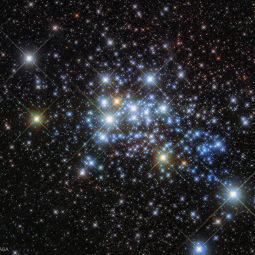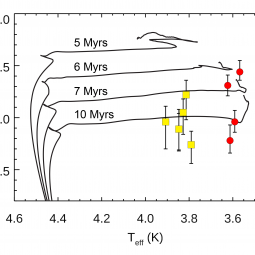By Emma Beasor
Paper:
The Age of Westerlund 1 Revisited
Beasor, Emma R., et al., 2021/05, ApJ, 912, 16.
A key aim of massive stellar evolutionary theory is to understand which stars end their lives as supernovae and which ones do not. This is particularly relevant as the Vera Rubin Observatory prepares to come online, initiating an era of big-data, time-domain surveys where new supernovae will be discovered at a high rate every single night. For low-mass stars, their evolution can be understood by studying old, globular clusters. To do the same for massive stars, we must observe benchmark young massive clusters, for which we have determined the age, where we can see stellar evolution in action.
Westerlund 1 is a nearby Milky Way cluster, the only known analogue to the bright clusters seen in metal rich starburst galaxies where all of the individual stars can be resolved. Provided an age can be determined, this makes Westerlund 1 an ideal benchmark system for studies of more distant, high-redshift starburst galaxies. Stellar models of massive stellar evolution are essential for studying these high-redshift galaxies, but the only cluster they can be calibrated against is Westerlund 1.
Westerlund 1 also contains extreme stellar diversity, hosting a large variety of massive stars including blue, yellow, and red supergiants as well as Wolf-Rayets, a magnetar, and a luminous blue variable. Currently, we know of no other cluster in the universe that contains this level of extreme stellar diversity. Grids of stellar models that include single stars are only able to explain the stellar diversity (and hence total brightness, colors, and ionizing flux of the cluster) if the age of Westerlund 1 is 5 Myr. Any younger and the red and yellow supergiants would not have had enough time to evolve and cool; any older and all of the Wolf-Rayet stars would have already ended their lives as H-poor supernovae. Of course, this depends on the assumptions of a distinct age and the use of single-star models.
If the age of Westerlund 1 were 5 Myr, not only would it be the most massive stellar cluster in the Milky Way, but single-star evolutionary models would predict that the red and yellow supergiants were some of the most luminous (>10 5.5 L ⊙ ) and massive (>30M ⊙ ) known. While the age of Westerlund 1 has been determined from the Wolf-Rayet and pre-main sequence stars, there have been no direct measurements of the luminosities of the cool supergiants.
Since red and yellow supergiants emit a large proportion of their flux at long wavelengths, optical as well as near-, mid-, and far-IR photometry is needed to determine the most accurate luminosities, but previous attempts have been hampered by saturated measurements from space-based observatories.
SOFIA FORCAST imaged Westerlund 1 in the wavelength range of 5.6 - 31.5 microns, covering a crucial portion of the spectral energy distribution where a large proportion of flux is emitted. Accessing wavelengths longer than 10 micron ensures any optical light lost to circumstellar extinction is captured when it is re-emitted at longer wavelengths.
The new FORCAST photometry was combined with complimentary, archival photometry at shorter wavelengths to derive a bolometric luminosity for each cool supergiant. The results are on average 0.5 dex too faint to be consistent with an age of 5 Myr. Instead, comparing the cool supergiants to stellar isochrones implies they are more consistent with an age of 10 Myr, and ages of less than 6 Myr are excluded at the 99.9% confidence level.
Including systematic uncertainties on distance and foreground extinction in revised age estimates for Westerlund 1 indicate that the best fit results are also consistent with the 10-Myr age implied by the cool supergiants.
The only remaining source of contention comes from the high-mass eclipsing binary system, W13, for which dynamical masses are estimated at 22 and 33M ⊙ . Eclipsing binaries can place an age limit on a system by taking the lifetime of the highest mass component in the system.
The age implied by the mass of the 33M ⊙ star, if that is the true initial mass, is younger than the cluster’s new inferred age. However, given this is a close eclipsing binary system, the more massive 33M ⊙ star could have potentially gained mass in stable mass transfer, meaning it was born with a lower initial mass. If this is the case, the true age could be older than that of a 33M ⊙ star, so it remains unclear if this is in contention with the cool supergiant age.
Given the low luminosities of the cool supergiants and the high mass for the eclipsing binary system, it is clear that a single age of 5 Myr cannot explain the stellar population of Westerlund 1. Instead, it is likely Westerlund 1 is not a coeval starburst cluster, but the product of a prolonged period of star formation lasting roughly 5 Myr. Whatever the reason, given the presence of an older, lower mass cool supergiants population, Westerlund 1’s position as the most massive cluster in the Milky Way must be evaluated. In addition, Westerlund 1 is not an appropriate benchmark object for studies of distant starburst galaxies or for calibrating stellar evolutionary models. Indeed, while Westerlund 1 may not be a Rosetta Stone object for stellar evolution, it certainly highlights how complex and surprising the universe can be.

